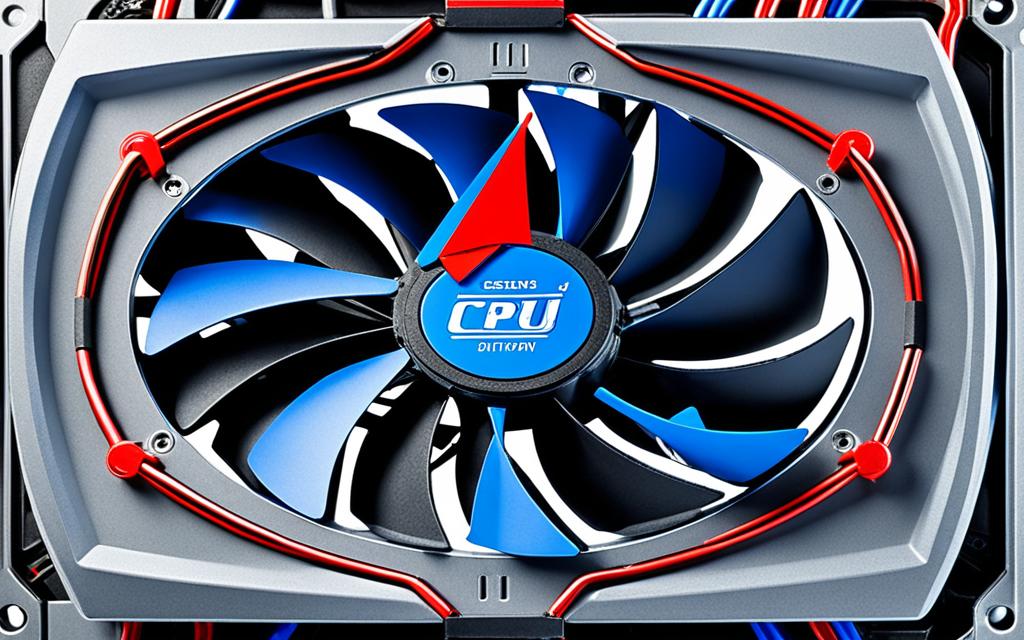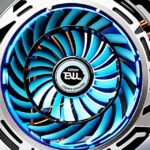Table of Contents
Knowing how CPU fans should blow air is key to keeping your computer cool. The way the fan moves air matters a lot for temperature control. It influences how well your machine runs and lasts. If your CPU fan faces the right way, you can avoid your computer overheating and breaking down. This guide will help you understand which direction your CPU fan should go. It lets you improve your computer and make better choices about cooling1.
Key Takeaways
- The direction of CPU fan airflow is vital for efficient thermal management.
- Identifying the correct fan orientation can prevent system overheating.
- Both intake and exhaust fans play critical roles in maintaining a balanced airflow.
- Regular maintenance, such as dust removal, is necessary for optimal cooling performance.
- Choosing the right fans can enhance the overall cooling efficiency of a build.
Understanding CPU Fan Airflow Basics
When you start looking into computer parts, you quickly learn how important the CPU fan is. It’s key to keeping the computer cool. By moving air the right way, it helps the whole system stay at the right temperature. This is why knowing how air moves through your computer matters a lot.
The Role of CPU Fans in System Cooling
CPU fans get rid of hot air and take in cooler air. Most fans are either 120mm or 140mm, but 200mm fans are getting popular again2. A good fan can move over 50 cubic feet of air per minute. That’s crucial for keeping things cool2. When doing heavy tasks, fans speed up. For example, at 65 degrees Celsius, they might run at 75% speed to control heat well3.
Importance of Correct Airflow Direction
Knowing how air should flow through the computer is key. It’s about positive, negative, and neutral air pressures. Positive pressure means more air is coming in than going out. Negative is the opposite2. Getting this balance right can make cooling much better. Also, most PCs are set up to take air in the front and out the back from the start2. Changing fan speeds based on the CPU’s warmth matters too. For instance, fans run at 50% for temperatures between 0 and 60 degrees Celsius3.
Identifying Fan Airflow Direction
Learning the airflow direction of a fan can boost your PC’s cooling. Fans are key for keeping your PC’s temperature just right. Knowing where they face is crucial for their best work. There are a few ways to figure this out, like looking at the fan itself or how its blades are shaped.
Visual Indicators on the Fan
Some fans have airflow indicators, like tiny arrows, showing air flow direction. But not all models have these helpful arrows. If your fan lacks arrows, look at the frame side connecting to the motor – air usually flows out here. Trying the fan when it’s not mounted lets you feel the air direction. This helps you know which side pulls air in and which pushes it out45.
Observing Fan Blade Orientation
The way fan blades curve is a key clue for identifying fan direction. Blades curve outward on one side and inward on the other. The air moves from the outward curve to the inward one. This shows if the fan draws air in or ejects it out. But, fan models vary, so this can sometimes be confusing4. Running the fan in its intended position helps you get its airflow right. It’s important to watch these hints to set up your cooling properly.
Which Way Does CPU Fan Blow?
Knowing how your CPU fan works is key for keeping your system cool. The CPU fan blow direction is crucial for airflow in your PC. We’ll look into intake vs exhaust setups and popular PC fan configurations to keep temperatures ideal.
Intake vs. Exhaust Orientation
CPU fans can either pull cool air in (intake) or push warm air out (exhaust). This choice greatly affects your system’s cooling. A good setup usually has more intake fans than exhaust. This balance improves air flow. Getting it wrong means heat gets stuck inside, harming performance and possibly damaging parts. Luckily, many cases show which way the air flows with arrows6.
Common Configurations in PC Builds
Most setups use a front-to-back air flow. This helps push hot air from the CPU and GPU out of the case. Some users try custom setups to cool specific parts better7. It’s also important to understand air pressure’s effect—whether it’s neutral, positive, or negative. A well-thought-out setup can keep your gear cool and make it last longer8.
Optimising Airflow for Effective Cooling
For optimal cooling, it’s vital to understand airflow pressure. You can choose between positive pressure and negative pressure systems. Each has its benefits. Positive pressure systems have more intake fans. This means cooler, cleaner air gets in, boosting performance. On the other hand, negative pressure systems use more exhaust fans. They’re great at pushing out heat, which stops your system from getting too hot during heavy use. It’s important to get the balance right to keep air moving well.
This balance stops air from getting stuck. If air doesn’t move, your system’s cooling won’t be as good. Check out this link for more on how it all works.
Positive vs. Negative Pressure Systems
It’s key to balance your intake and exhaust fans for good airflow. Too many intake fans with no way for air to get out can trap hot air. That’s bad for keeping things cool9. Also, if the air can’t flow well because of poor design, your system won’t perform as well10. Making sure air can move freely is crucial. Blocked airflow can really mess up your system’s cooling.
Mounting Fans for Maximum Efficiency
Where you put your fans matters a lot for cooling. If two fans face each other, they can mess up the airflow10. A better setup, like a tower cooler, helps hot air leave your system. This keeps everything cooler10. Also, air ducts need good angles for smooth airflow. A well-thought-out airflow plan in your chassis can make your cooling way better. It might even mean you don’t need extra fans10.
Choosing the Right Fans for Your Build
Choosing the right fans for your PC is crucial. You need to consider a lot of things to get the best cooling. It’s important to know about fan specs, noise, and how to arrange them for top cooling.
Factors to Consider When Selecting Fans
When picking fans, think about:
- RPM: Fans usually work between 500-2000 RPM. Higher RPM means better cooling but can be louder and wear out faster11.
- CFM: This shows how much air a fan moves. Choosing between static pressure fans or airflow fans based on CFM is crucial for your setup.
- Noise Levels: Fans can range from very quiet at 15 dB to loud at 40 dB. More RPM usually means more noise11.
- Size: The common sizes are 120mm and 140mm. Bigger fans are often better because they move more air quietly11.
- Configurations: Getting the right mix of air coming in and going out can help with cooling and reduce dust11.
Recommended Fan Models for Optimal Performance
The top fans based on reviews and reliability are:
| Fan Model | Size | Performance | Noisiness | Price Range |
|---|---|---|---|---|
| Arctic P12 PWM | 120mm | Excellent air movement with low noise | 15-25 dB | £8 – £12 |
| be quiet! Pure Wings 2 | 120mm | High efficiency at a reasonable price | 19-28 dB | £10 – £15 |
| Noctua NF-A12x25 | 120mm | Top-tier performance, quieter operation | 12-25 dB | £25 – £30 |
These fan models are great for performance, noise, and price12. To make them last, think about where you put them and how you clean them13.
Conclusion
Knowing which way the CPU fan should blow is key to keeping computers cool. Most fans push air towards the heatsink. This helps get rid of heat, which is vital for the CPU’s health and speed1415. Choosing the right parts and putting them in the best spot makes a big difference in temperature control. This helps computers work well, even when they’re really busy.
To make cooling even better, leave space around the CPU fan and tidy up the cables14. Cleaning the fan often also stops dust from hurting the cooling power. This prevents the computer from getting too hot15.
Understanding fan setup is important for anyone building a PC. It ensures the computer runs smoothly. For more details on which way fans should blow, click here.
FAQ
How do I determine the airflow direction of my CPU fan?
You can look for arrows on the fan casing to find the airflow direction. If there aren’t any arrows, check the fan blades. Blades curving away mean intake, and those curving towards you are for exhaust.
What is the difference between intake and exhaust fans?
Intake fans pull cool air into your computer case. On the other hand, exhaust fans push warm air out. Having the right setup is key for your system to stay cool and work well.
Why is correct airflow direction so important?
The right airflow direction helps your computer avoid overheating. It keeps temperatures safe, boosts performance, and makes your components last longer.
What are the benefits of positive and negative pressure systems?
Systems with more intake than exhaust fans improve air quality inside and reduce dust. Those with more exhaust help remove heat but might let in dust.
What factors should I consider when selecting fans for my PC?
Consider how well they work, how much noise they make, and how they look. Choosing fans that move air well without much noise will make for a better experience.
Can I configure CPU fans in different ways for my cooling needs?
Yes, you can set up CPU fans in unique ways to cool specific parts. This might help you create a cooling solution that’s right for your system.
What are some recommended CPU fan models for consistent performance?
Some top picks include the Arctic P12 PWM, known for its value and effectiveness. The be quiet! Pure Wings 2 offers great performance at a good price. Noctua’s NF-A12x25 is high-quality, though more expensive upfront.
Source Links
- https://www.pcworld.com/article/394576/how-to-tell-which-way-your-fan-is-blowing.html – How to tell which way your fan is blowing
- https://www.tomshardware.com/how-to/set-up-pc-case-fans-for-airflow-and-performance – PC Airflow Guide: How to Set Up and Position Your Fans
- https://www.reddit.com/r/buildapc/comments/dz2uih/tip_for_new_builders_case_and_cpu_fan_curves/ – Reddit – Dive into anything
- https://www.techpowerup.com/forums/threads/how-to-know-the-case-fan-is-input-ouput.301978/ – How to know the case fan is input/ouput?
- https://forums.anandtech.com/threads/how-to-tell-fan-direction.2209232/ – How to tell fan direction
- https://www.cgdirector.com/pc-fan-airflow-direction/ – How to Tell Which Way Your PC’s Case & CPU Fans are Blowing
- https://forums.overclockers.co.uk/threads/cpu-water-cooler-which-way-should-i-point-the-fans.18829960/ – CPU water cooler which way should I point the fans?
- https://forum.level1techs.com/t/orientation-of-low-profile-cpu-cooler/167100 – Orientation of low profile CPU cooler?
- https://www.physicsforums.com/threads/airflow-direction-improving-the-cooling-of-my-computer.977917/ – Airflow direction — Improving the cooling of my computer
- https://www.silverstonetek.com/en/tech-talk/wh_airflow – Tech Talk∣SilverStone
- https://www.xda-developers.com/pc-airflow-guide/ – PC airflow guide: How to strategically set up your case fans
- https://www.lenovo.com/us/en/glossary/fan/ – How Does a Computer Fan Work? | Different Types Explained
- https://www.askteamclean.com/us/en/cleaning/how-to-clean-a-pc-fan.html – How to Clean a PC fan
- https://ms.codes/blogs/computer-hardware/cpu-fan-which-way-does-it-blow – CPU Fan Which Way Does It Blow
- https://ms.codes/en-ca/blogs/computer-hardware/which-way-does-cpu-fan-blow – Which Way Does CPU Fan Blow








